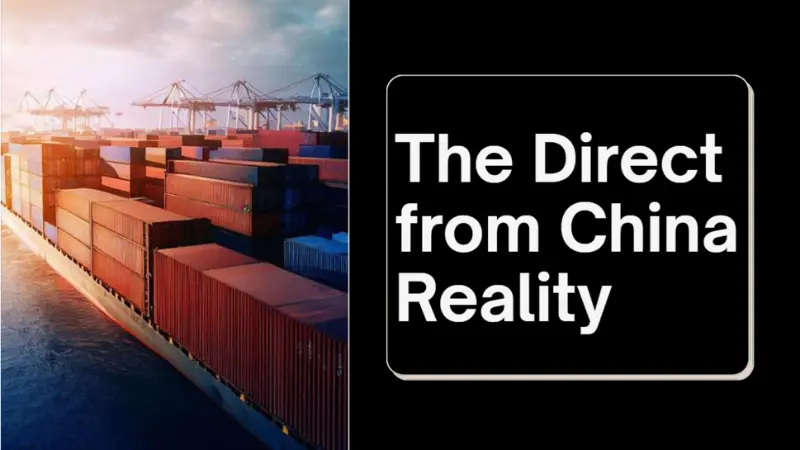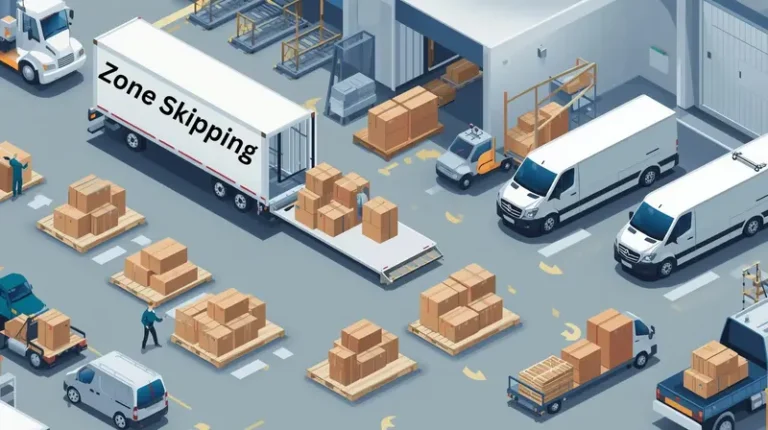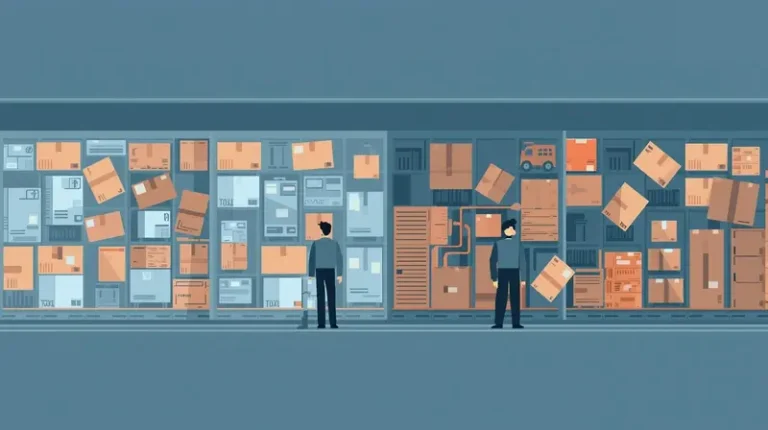Shipping Direct From China: Pros And Cons of Models Like Portless

Last updated on August 27, 2025

In this article
 8 minutes
8 minutes
- What Direct From China Actually Means
- The Real Benefits In 2025
- The Pitfalls Everyone Underestimates
- When Direct From China Makes Sense
- When You Should Avoid It
- A Simple Model To Pressure Test The Idea
- Buying From Manufacturers Without Getting Burned
- Returns And Customer Care
- What I Would Do Before Flipping The Switch
- How Portless-Style Models Work, And Why 2025 Changed the Game
- The Bottom Line
- Frequently Asked Questions
Direct from China sounds like cheat codes. Inventory sits at the China factory, orders flow, parcels fly, and you pocket the cash before you pay duties. In a soft demand cycle, that cash-flow relief is real. But in 2025, the rules changed. Tariffs moved, the de minimis door is closed, and customer expectations got even sharper. I want to lay out where the direct from China model shines, where it hurts, and how to run the numbers before you commit.
What Direct From China Actually Means
At a simple level, you store finished products inside China, then ship parcels directly to end customers when they buy. No US warehouse, less capital tied up, fewer bulk shipments. Most brands ride a network of special lines that consolidate in China, inject into local postal networks on arrival, and deliver with full tracking. For lightweight items and steady demand, it can be a smart bridge between prototype and scale.
Slash Your Fulfillment Costs by Up to 30%
Cut shipping expenses by 30% and boost profit with Cahoot's AI-optimized fulfillment services and modern tech —no overheads and no humans required!
I'm Interested in Saving Time and MoneyThe Real Benefits In 2025
1. Cash flow and lower working capital: You pay import taxes against revenue that has already been cleared, rather than prepaying duties on bulk containers. That can be the difference between testing ten products and testing two.
2. Faster product iteration: When manufacturers can ship samples and micro batches quickly, product teams learn faster. You avoid months of wrong inventory sitting in a US warehouse.
3. Flex on assortment: If the factory can kitting-pack on demand and hold multiple main products, you can widen the choice without buying deep. That matters when quality, color, and size curves are still unknown.
4. Potentially competitive transit times: Special line carriers like YunExpress or 4PX can hit 6 – 12 days to the US with trackable milestones. Not Prime-fast, but fast enough for certain categories if expectations are set.
The Pitfalls Everyone Underestimates
1. Tariffs, duties, and the end of de minimis: As of late August 2025, low-value shipments no longer slide through the US under the $800 de minimis treatment. That means most parcels face duties and fuller customs handling. If your pricing assumes duty-free delivery, your margin math is off. Some marketplaces will also treat you like a full importer, with extra data and security requirements.
2. Delivery experience and returns: Even good special lines are not domestic carriers. Weather holds, customs inspections, and routing shifts happen. Returns get expensive and slow when the origin is China. For apparel and accessories, that is a churn magnet.
3. Quality control without a US backstop: Product quality must be locked at the factory. If you discover a defect pattern in the wild, you eat replacements and international shipping. Vet your manufacturers, run pre-shipment inspection, and keep signed samples. Poor vendor management equals public one-star reviews.
4. Compliance and paperwork risk: Incorrect declared values, missing test reports, or flimsy certifications will jam parcels at the border and trigger audits. If you sell anything with batteries, skincare actives, magnets, or electronics, be extra careful. The cost is not just duties; it is time and trust.
5. IP and data exposure: When your suppliers or trading companies also serve other websites and buyers, opacity creeps in. You want clear contracts, controlled packaging files, and watermarking on pre-release assets. Keep sensitive information on company systems, not shared chat apps.
When Direct From China Makes Sense
- Small and light products that fit under key postal thresholds.
- Predictable quality with low return rates.
- Clear HS codes, clean certifications, and no hazmat.
- Customers are willing to accept 6 – 12-day delivery with honest ETAs.
- A brand in test-and-learn mode that values cash conservation over fastest speed.
When You Should Avoid It
- High-return categories like apparel with tricky fit or color variance.
- Regulated categories that draw extra inspection.
- Anything where product quality needs rework, steaming, or special packaging inspections.
- Premium brands that rely on two-day promises as part of their brand identity.
A Simple Model To Pressure Test The Idea
Pull a one-page table for your top five SKUs. For each, estimate: unit cost ex-factory, packing, special-line shipping, new duty rate, customs fees, and a realistic returns rate. Add a buffer for loss and non-delivery. Compare against US-based fulfillment: inbound ocean or air, drayage, duty on bulk import, warehouse storage, pick and pack, domestic label, and expected return cost. Whichever total cost per delivered order looks lower at your current order volume, that is your baseline. Then add two sensitivity tests: duty plus five points and transit plus four days. If your margin collapses on those, think twice.
Looking for a New 3PL? Start with this Free RFP Template
Cut weeks off your selection process. Avoid pitfalls. Get the only 3PL RFP checklist built for ecommerce brands, absolutely free.
Get My Free 3PL RFPBuying From Manufacturers Without Getting Burned
- Choose suppliers with clean third-party audits and consistent certifications.
- Pay for pre-shipment inspection and carton drop tests.
- Start with small bulk orders to validate actual defect rates before flipping to full direct from China.
- On custom packaging, confirm materials and print proofs with the factory, then lock revisions in writing.
- Keep key contracts clear on ownership of molds, brand assets, and tooling.
Returns And Customer Care
Two tactics help. First, route returns to a domestic partner that can triage, refurbish, and reship, so customers do not wait months for exchanges. Second, publish an accurate delivery window at checkout, not a best-case. If you are targeting 7 – 12 days, say 8 – 14 and beat it. Your return rate will thank you.
What I Would Do Before Flipping The Switch
- Map your HS codes and confirm duty exposure for each SKU.
- Run a four-week live pilot on a subset of traffic and measure conversion, delivery time, and refund rate.
- Build an exception playbook. Who handles lost parcels, re-labels, or address issues?
- Decide your future state. Many brands blend models: direct from China for long tail SKUs and testing, US warehouse for heroes. That hybrid often wins.
How Portless-Style Models Work, And Why 2025 Changed the Game
Portless and similar platforms pitch a turnkey promise: skip the US warehouse entirely, tap into a China-based network of factories and forwarders, and let them handle order routing and fulfillment to global customers. It’s an evolution of the factory-to-door model layered with software that syncs with your store, automates label creation, and consolidates shipments into fast cross-border lanes.
Why sellers loved it: The model eliminated bulk import headaches, cut upfront inventory costs, and gave smaller brands access to reliable shipping lanes without building their own infrastructure. For many, it was the fastest way to test new products, manage long-tail SKUs, and keep cash liquid.
But the landscape shifted in 2025.
- De Minimis Crackdown: With the US closing the $800 de minimis loophole, Portless-style models now face the same duty requirements as bulk importers. These costs erode the pricing advantage and introduce customs complexity that such platforms used to shield sellers from.
- Data Transparency Requirements: Marketplaces and regulators now demand full product-level data (materials, certifications, HS codes) before entry. Platforms relying on minimal compliance paperwork are scrambling to upgrade.
- Competitive Pressure: As more players adopt this model, differentiation shrinks. Portless itself competes not just with peers like Floship or ShipAnt, but also with traditional 3PLs that have added China-direct options under a hybrid approach.
- Customer Experience Risks: While tech-driven platforms offer visibility, they’re still subject to cross-border realities, customs holds, weather delays, and return complexity. With rising consumer expectations, “almost Prime” isn’t enough for many categories.
For brands, this means due diligence is non-negotiable. Evaluate not just rates and transit times, but how your provider is adapting to new regulatory and market pressures. The Portless model can still deliver value, but only if paired with solid compliance, quality controls, and a backup plan for domestic fulfillment.
For platforms like Portless, BoxC, and the like, the message is clear: adapt or lose ground. Sellers will demand end-to-end transparency, multi-country node options, and automated duty/tax calculation baked into the experience. Those who can’t provide it risk being replaced by hybrid providers that combine offshore flexibility with domestic speed.
Scale Faster with the World’s First Peer-to-Peer Fulfillment Network
Tap into a nationwide network of high-performance partner warehouses — expand capacity, cut shipping costs, and reach customers 1–2 days faster.
Explore Fulfillment NetworkThe Bottom Line
Direct from China is not a fad; it is a tool. A tool that works best for light products with clean compliance and patient customers. Cash flow improves, assortment expands, and learning accelerates. But tariffs are real, returns are painful, and one weak link in quality or paperwork can erase the savings. Treat this like a finance project, not a vibe, and it can be a competitive edge.
Frequently Asked Questions
What Changed About De Minimis And Why Does It Matter?
The US suspended the duty-free treatment for low-value shipments, so most small parcels now face duties and fuller customs processing. If your pricing relied on duty-free entry, your margin will shrink unless you adjust prices or shipping strategy.
How Fast Is Direct From China?
Most special lines deliver in roughly 6 to 12 days with tracking. Plan for longer windows if you sell during peak periods or route through congested gateways.
What Products Fit This Model Best?
Light, durable goods with low return risk. Think accessories, small electronics with clean certifications, or non-fitted home goods. Apparel with high return rates is usually a bad fit.
Can I Mix China Direct With A US 3PL?
Yes. Many brands use factory-to-door for long tail and keep top sellers in US warehouses for two-day promises and easy returns. That hybrid balances cash flow and customer experience.
How Do I Control Quality Without A US Backstop?
Pay for pre-shipment inspections, hold signed golden samples, and run acceptance testing per lot. If you see defect rates creeping up, stop shipments, investigate at the factory, and revert to US fulfillment for affected SKUs.

Turn Returns Into New Revenue





